Why this resume works
- Quantifies accomplishments: Highlighting measurable accomplishments like improving machine efficiency by 20% reveals the applicant’s impact and value.
- Showcases career progression: From repair specialist to maintenance mechanic, the applicant’s career path reflects a steady climb in responsibility and expertise, showcasing their growth in the mechanical field.
- Illustrates problem-solving ability: Resolving 30% of equipment faults showcases the applicant’s problem-solving skills, critical thinking, and initiative.
More Maintenance Mechanic Resume Examples
Explore our maintenance mechanic resume examples to see how to effectively highlight your repair skills, equipment knowledge, and troubleshooting expertise. These maintenance resume samples offer guidance on presenting your experience in line with industry expectations.
Entry-Level Maintenance Mechanic
Why this resume works
- Effective use of keywords: Strategically using role-relevant keywords like “preventive maintenance” and “safety compliance” aids in passing applicant tracking systems (ATS).
- Puts skills at the forefront: The skills-based resume format ensures key capabilities such as project management and mechanical troubleshooting are prominently displayed.
- Shows digital literacy: Incorporating tools and platforms, such as implementing a tracking system, shows computer skills and digital readiness for modern workplaces.
Mid-Level Maintenance Mechanic
Why this resume works
- Points to measurable outcomes: By reducing downtime by 30% and saving $10K annually, the applicant showcases a knack for achieving significant operational improvements through targeted maintenance strategies.
- Displays technical expertise: Certifications like Certified Maintenance Professional and OSHA Safety Certification highlight the applicant’s technical expertise essential for ensuring safety and efficiency in maintenance roles.
- Demonstrates language abilities: Language skills in Spanish, German, and French support cross-cultural communication and improve the applicant’s versatility in diverse work environments.
Experienced Maintenance Mechanic
Why this resume works
- Showcases impressive accomplishments: By reducing operating costs by $50k annually and introducing energy-saving solutions, the applicant’s accomplishments speak volumes about their senior-level impact.
- Focuses on work history: The chronological resume format highlights a rich history of evolving roles and responsibilities over an extensive maintenance career.
- Emphasizes leadership skills: Managing a team to maintain over 100 equipment units showcases leadership skills that highlight the applicant’s ability to guide and oversee complex tasks.
Maintenance Mechanic Resume Template (Text Version)
Jane Johnson
Brookfield, WI 53011
(555)555-5555
Jane.Johnson@example.com
Professional Summary
Skilled maintenance mechanic with 8+ years boosting equipment efficiency and reducing downtime. Expert in troubleshooting, safety compliance, and proactive maintenance strategies.
Work History
Maintenance Mechanic
Precision Industrial Services – Brookfield, WI
May 2022 – October 2025
- Improved machine efficiency by 20%
- Reduced downtime by 15% through targeted repairs
- Led team for critical maintenance projects
Equipment Technician
Advanced Mechanical Corp – Brookfield, WI
February 2018 – April 2022
- Troubleshot and resolved 30% of equipment faults
- Assisted in cost savings by 10% in parts management
- Developed preventive maintenance schedules
Repair Specialist
Integrity Maintenance Solutions – Brookfield, WI
October 2015 – January 2018
- Enhanced workflow efficiency by 25%
- Conducted safety inspections, reducing risks by 30%
- Trained junior staff in repair techniques
Skills
- Preventive maintenance
- Troubleshooting
- Hydraulic systems
- Blueprint reading
- Safety compliance
- Equipment installation
- Time management
- Mechanical repairs
Education
Master of Science Mechanical Engineering
Illinois State University Normal, Illinois
May 2015
Bachelor of Science Industrial Technology
Southern Illinois University Carbondale, Illinois
December 2012
Certifications
- Certified Maintenance Technician – National Maintenance Association
- OSHA Safety Certification – Occupational Safety and Health Administration
Languages
- Spanish – Beginner (A1)
- German – Intermediate (B1)
- French – Beginner (A1)
Related Resume Guides
Advice for Writing Your Maintenance Mechanic Resume
Explore our advice on how to write a resume for a maintenance mechanic position, where you’ll find tailored tips to highlight your technical skills, problem-solving abilities, and hands-on experience. Whether you’re new to the field or looking to advance your career, discovering how to craft a standout resume that speaks directly to hiring managers in your industry is key.
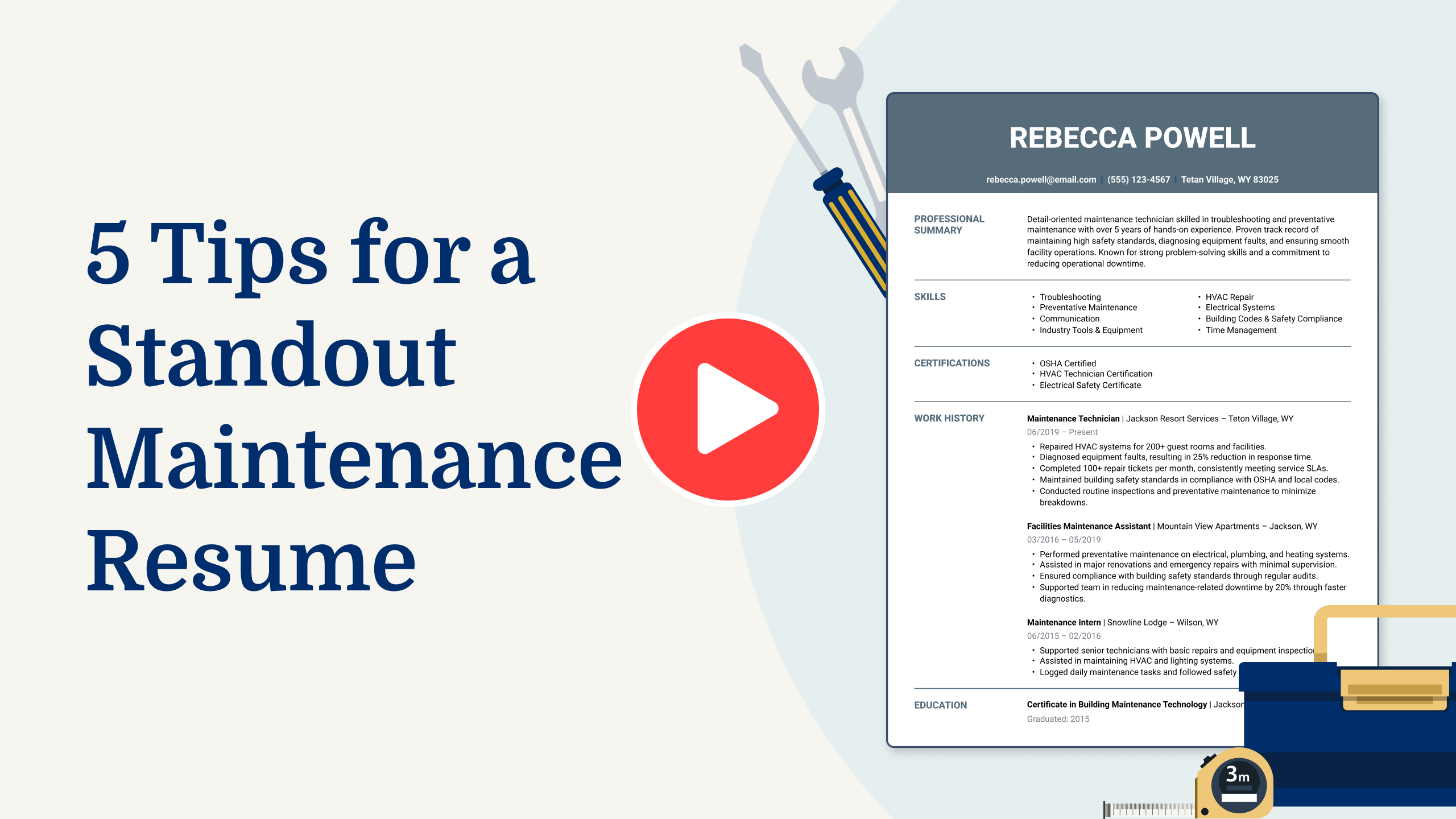
Highlight relevant technical skills
For a maintenance mechanic, technical skills are key to performing the job well. Including a dedicated skills section on your resume can help you stand out by showcasing abilities tied to machinery, tools, and repair techniques. It’s helpful to highlight experience with equipment such as hydraulic systems, pneumatic devices, and mechanical tools.
Additionally, emphasizing your expertise in troubleshooting and repairing complex systems can make you appear more equipped for the role. If you decide to incorporate technical skills into your work experience section instead of separating them out, ensure they flow naturally within descriptions of prior roles.
For instance, while detailing responsibilities at a previous company, explain how you effectively operated specific machines or tools. This method not only illustrates what you’ve accomplished but also demonstrates how those skills contributed to concrete outcomes.
Maintenance mechanics often need knowledge of electrical systems, welding and soldering abilities, machine operation expertise, and familiarity with safety protocols. Highlighting these technical skills on your resume shows employers you’re prepared for the challenges of the position.
Example of a technical skills section
- Mechanical system troubleshooting
- Predictive and preventive maintenance
- Hydraulic and pneumatic systems repair
- Electrical circuitry diagnostics
- Plc programming (allen-bradley, siemens)
- Cnc machine operations and maintenance
- Welding and fabrication techniques
- Hvac system maintenance
- Computerized maintenance management system (cmms)
You can use our Resume Builder to craft a resume that highlights technical skills in addition to key soft skills like teamwork, communication, and adaptability.
Quantify your accomplishments
Quantifying accomplishments in your resume makes it much more effective than simply listing job duties. For a maintenance mechanic, turning responsibilities into measurable achievements demonstrates the direct impact of your work.
Hiring managers can quickly understand how you’ve contributed to efficiency, saved costs, or improved operations. For example, instead of writing “performed maintenance on machinery,” you could say “reduced downtime by 20% through preventive maintenance strategies.” Numbers and metrics show the results of your work and make your experience stand out.
In the work experience section, each entry should include your job title, employer name, location, and employment dates. Then focus on action verbs and specific outcomes to highlight what you accomplished. For instance, rather than stating “repaired equipment,” write “streamlined repair processes to cut average resolution time by 15%.” Showing tangible results like cost savings or increased productivity gives hiring managers a clear picture of your value.
Using metrics and action-oriented language creates a results-driven resume that helps employers assess your skills quickly. Quantified accomplishments give them confidence in your ability to deliver real improvements. Whether it’s increasing efficiency or saving money for the company, showcasing these successes can make all the difference in landing an interview for a maintenance mechanic role.
5 maintenance mechanic work history bullet points
- Performed routine inspections and maintenance on machinery, decreasing equipment failure rates by 25% over a year.
- Implemented a predictive maintenance schedule, resulting in a 40% reduction in unplanned machine downtime.
- Led a team of 3 technicians to overhaul the facility’s HVAC system, improving energy efficiency by 15%.
- Diagnosed and repaired complex mechanical issues on production lines, increasing operational productivity by 20%.
- Trained and mentored junior mechanics on best practices, improving team skill levels and reducing repair times by 10%.
Need help with your resume? Check out our professional resume examples to find great ideas and make your own stand out.
Write a powerful professional summary
A professional summary on a resume serves as an engaging introduction to hiring managers. Job seekers can choose between a summary or an objective, depending on their experience level and career goals. This choice sets the tone for the remainder of the resume and determines how applicants present themselves.
Typically three to four sentences long, a professional summary highlights your experience, skills, and achievements. It’s ideal for experienced applicants like maintenance mechanics who want to showcase their professional identity and value in the workforce. The goal is to quickly convey why you are a strong fit for the role based on what you have accomplished.
In contrast, resume objectives focus on career goals and suit entry-level applicants, those changing careers, or individuals with employment gaps. While summaries emphasize “what I’ve accomplished,” objectives center on “what I aim to contribute.” Both serve distinct audiences and purposes.
Explore examples of both summaries and objectives tailored for various industries and experience levels, helping you craft a compelling introduction no matter where you are in your career journey.
Maintenance mechanic resume summary examples
Entry-level
Recent graduate with an associate degree in industrial maintenance technology and certification in OSHA safety standards. Completed hands-on training in equipment troubleshooting, preventive maintenance, and basic electrical repairs during internship at a manufacturing facility. Eager to apply foundational mechanical knowledge to ensure smooth operations and reduce downtime.
Mid-career
Experienced maintenance mechanic with 7+ years working in manufacturing environments, specializing in machinery diagnostics, hydraulic systems repair, and implementing cost-effective solutions for equipment upgrades. Skilled in reading blueprints, conducting routine inspections, and collaborating with production teams to minimize disruptions. Recognized for improving machine reliability and reducing repair times by 15% annually.
Experienced
Seasoned maintenance mechanic with over 15 years of expertise in managing large-scale industrial equipment across multiple facilities. Advanced skills in programmable logic controllers (PLC), predictive maintenance strategies, and leading cross-functional teams during critical system overhauls. Proven track record of reducing operational costs through improved machine efficiency while mentoring junior technicians to improve team capabilities.
Maintenance mechanic resume objective examples
Entry-level
Driven individual with hands-on technical training in mechanical systems seeking an entry-level maintenance mechanic position. Excited to contribute to equipment upkeep and operational efficiency while expanding knowledge in machinery diagnostics and repairs.
Career changer
Detail-oriented professional transitioning into maintenance mechanics, leveraging a background in problem-solving and system troubleshooting from previous roles. Eager to apply transferable skills like mechanical aptitude and teamwork to ensure reliable equipment performance.
Recent graduate
Ambitious trade school graduate specializing in industrial maintenance technology aiming for a maintenance mechanic role. Ready to support a team by applying newly acquired skills in preventive maintenance, machine inspections, and safety practices.
Choose a resume template that is simple and professional, featuring clear sections and easy-to-read fonts. Avoid flashy designs or crowded layouts to keep the focus on your qualifications.
Showcase your credentials
Listing your credentials, like certifications and licenses, is key for a maintenance mechanic. These show that you have the skills needed to do the job right. In technical fields, having proof of specialized training can set you apart from others. Adding a certifications section to your resume helps employers see your qualifications quickly. Here are a few examples of relevant certifications for your resume:
- Certified Maintenance & Reliability Technician (CMRT)
- HVAC Certification
- EPA Section 608 Technician Certification
- OSHA Safety Certificate
- Forklift Operator Certification
Certifications help prove you know how to handle specific tasks and tools safely and effectively. For a maintenance mechanic, they can mean the difference in getting hired or promoted. Make sure these are easy to find on your resume by creating a dedicated section.
Example of a certifications section
Certified Maintenance & Reliability Technician (CMRT)
Issued by: Society for Maintenance & Reliability Professionals (SMRP)
Issued 2022
EPA 608 Technician Certification
Issued by: Environmental Protection Agency
Expires 2025
OSHA 30-Hour General Industry Safety Certification
Issued by: Occupational Safety and Health Administration (OSHA)
Issued 2021
HVAC Excellence Certification
Issued by: ESCO Institute
Expires 2024
Forklift Operator Certification
Issued by: National Safety Council
: Issued 2023
Use a polished and professional resume format that aligns with your experience level to ensure your skills and qualifications stand out to hiring managers.
FAQ
Do I need to include a cover letter with my maintenance mechanic resume?
Yes, including a well-crafted cover letter with your maintenance mechanic resume can make a significant difference. A cover letter lets you highlight your mechanical skills and experiences that are most relevant to the job you’re applying for, showcasing your expertise in maintaining and repairing machinery.
For instance, if the company uses specific equipment or systems you have experience with, mention this to demonstrate your value.
To assist you, our Cover Letter Generator offers step-by-step guidance and expert suggestions to help create a tailored cover letter based on your resume.
Additionally, reviewing our collection of cover letter examples can give you insight into how to effectively convey your qualifications and interest in the maintenance field.
How long should a maintenance mechanic’s resume be?
For a maintenance mechanic, a concise one-page resume is often sufficient to highlight your key skills and experiences. Focus on listing relevant certifications, specific machinery or systems you’re proficient with, and notable achievements in previous roles.
If you’ve accumulated extensive experience or specialized training, a two-page resume might be more appropriate. This allows you to detail significant projects and demonstrate your depth of expertise without overwhelming the reader.
Ultimately, how long a resume should be depends on your unique career history. Ensure every piece of information included is directly relevant to the maintenance mechanic role to keep it engaging.
How do you write a maintenance mechanic resume with no experience?
Crafting a resume with no experience can still showcase your potential and enthusiasm for a maintenance mechanic position. Focus on transferable skills, relevant training, and any hands-on projects to demonstrate your readiness for the role.
- Emphasize relevant education: If you’ve completed courses or training in mechanics, list them prominently. Include any certifications that show your commitment to learning the trade.
- Showcase transferable skills: Highlight skills like problem-solving, attention to detail, or manual dexterity gained from hobbies or volunteer work. These are valuable in mechanical roles.
- Highlight projects and hands-on experiences: Mention any personal projects or tasks where you applied mechanical knowledge, such as vehicle repairs or home maintenance. Describe what you did and the tools used.
- Include soft skills and attributes: Focus on qualities like reliability, teamwork, and eagerness to learn—traits that employers value highly even when technical experience is limited.
Consider checking out resources on writing a resume with no experience to further improve your application with structured examples and tips tailored to entry-level applicants.
Rate this article
Maintenance Mechanic
Additional Resources
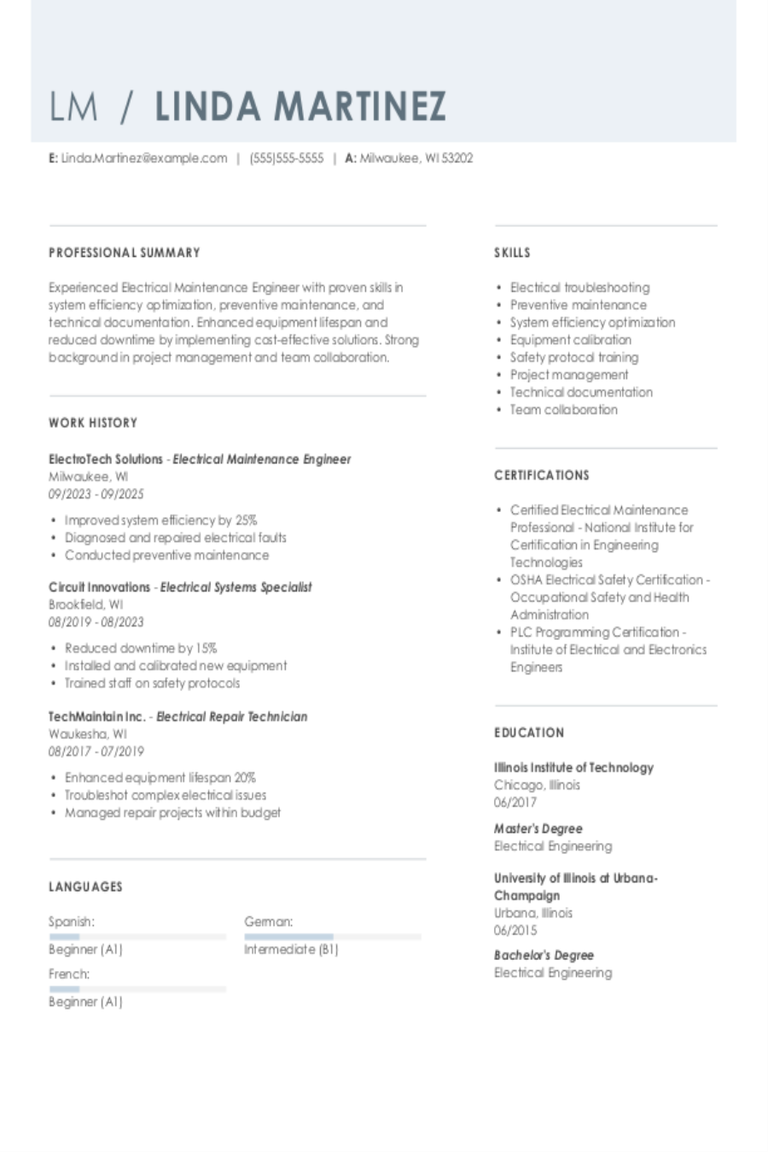
Electrical Maintenance Engineer Resume Examples & Templates for 2025
Explore electrical maintenance engineer examples and tips to learn how to effectively showcase your hands-on experience, teamwork, and problem-solving expertise.Build my resumeImport existing resumeCustomize this templateWhy this resume worksQuantifies accomplishments: By
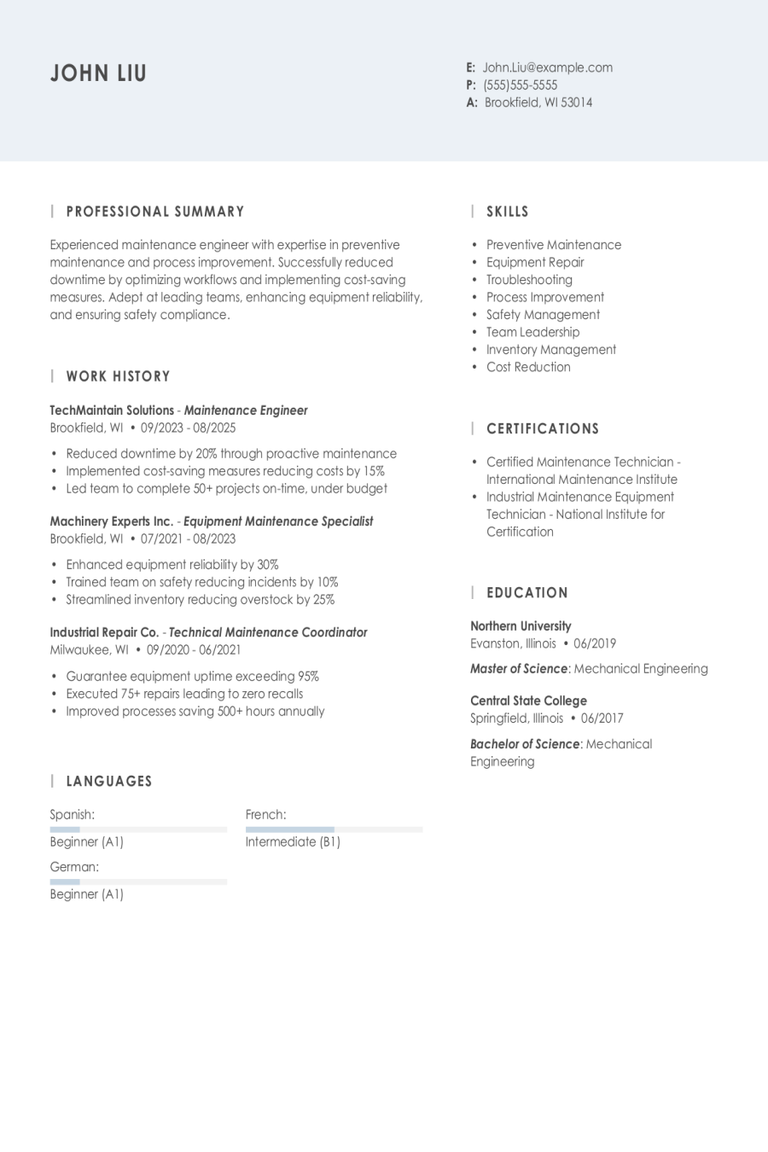
Maintenance Engineer Resume Examples & Templates for 2025
Explore maintenance engineer resume examples to see how to highlight your problem-solving skills and your experience working safely and keeping machines running smoothly.Build my resumeImport existing resumeCustomize this templateWhy this
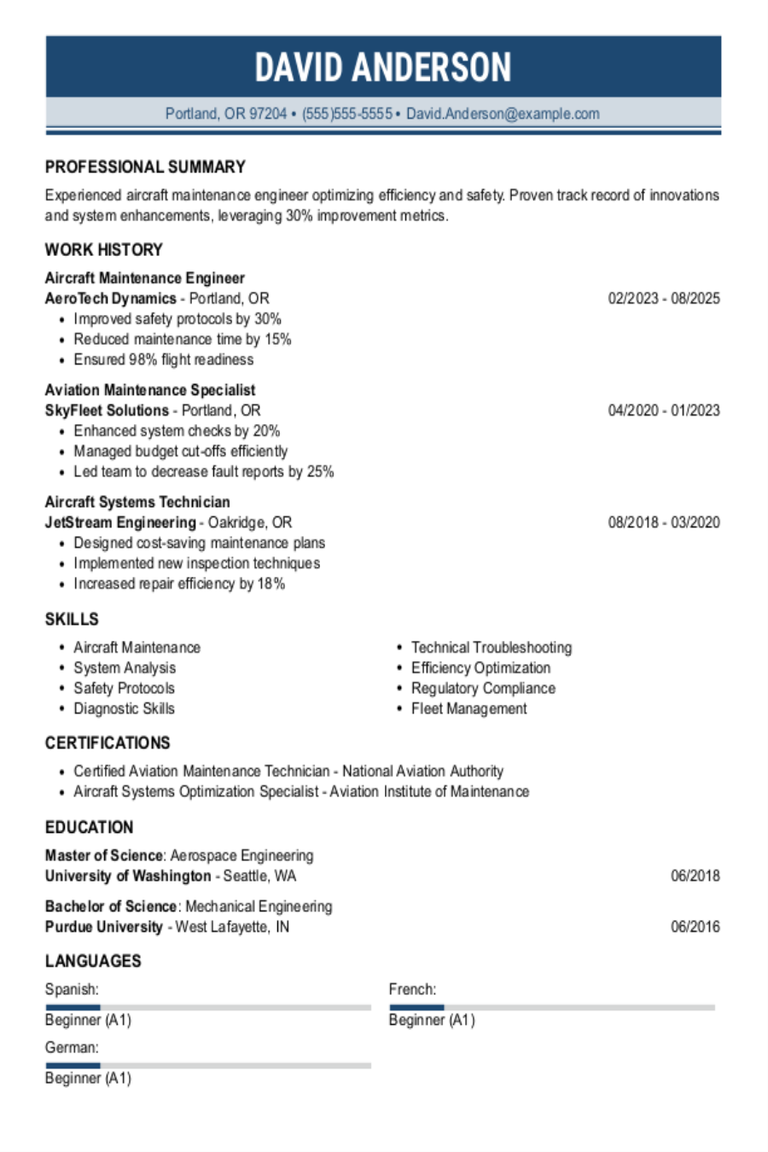
Aircraft Maintenance Engineer Resume Examples & Templates for 2025
Explore aircraft maintenance engineer resume examples that showcase skills in repairing and maintaining aircraft. These samples and tips can help you highlight your technical know-how and experience to stand out
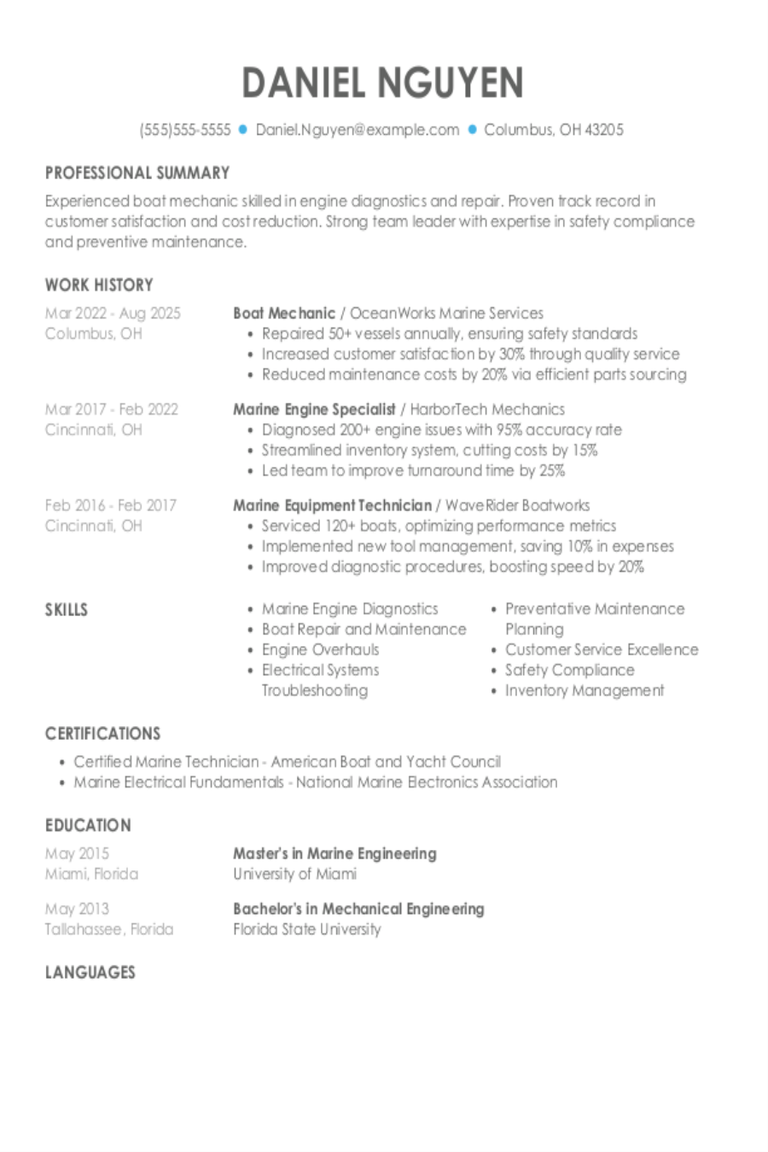
Boat Mechanic Resume Examples & Templates for 2025
Explore boat mechanic resume examples to see how to highlight experience fixing engines, diagnosing problems, and doing regular maintenance. Discover tips to showcase your skills in keeping boats running smoothly
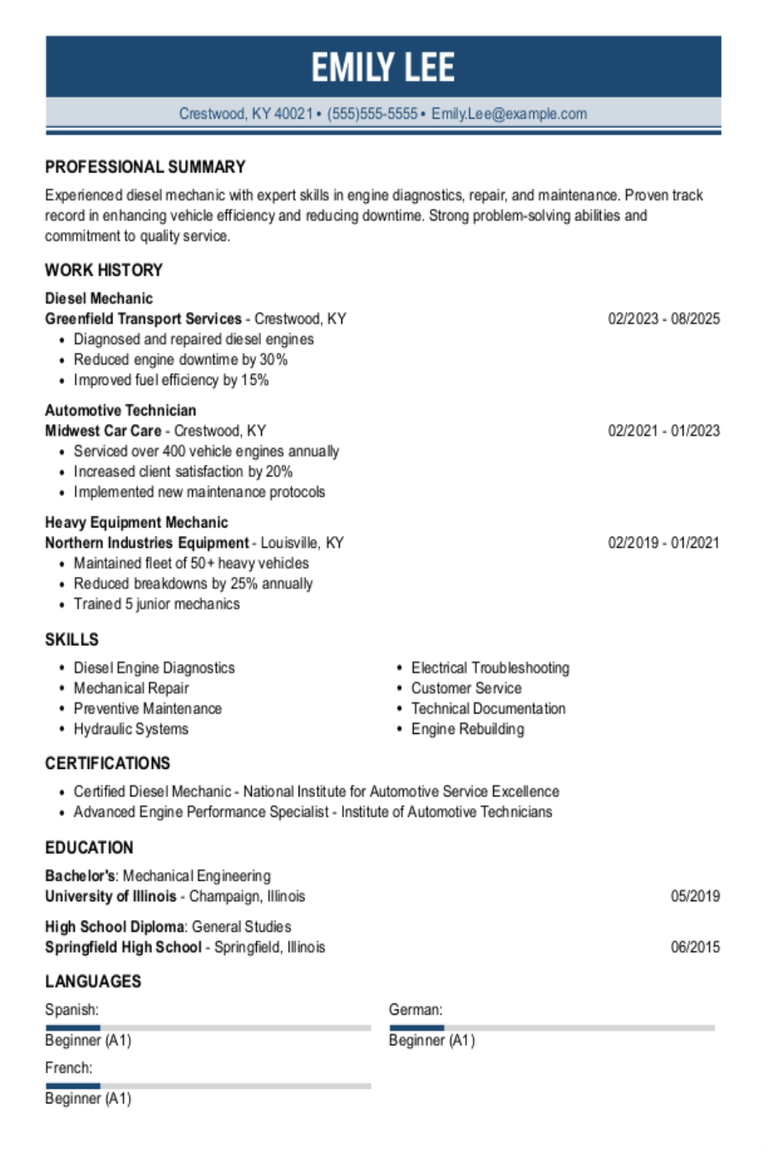
Diesel Mechanic Resume Examples & Templates for 2025
Explore diesel mechanic resume examples to see how to list repair skills and experience working with heavy equipment. Use these samples and tips to share hands-on experience that stands out
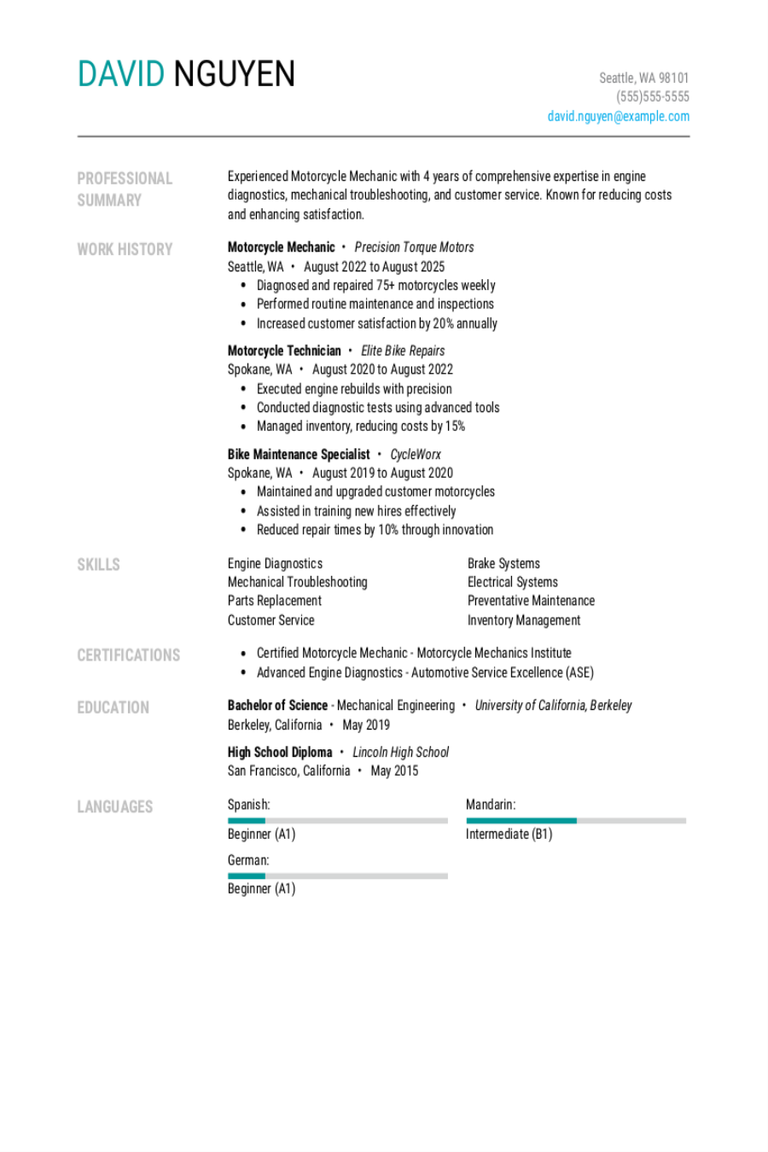
Motorcycle Mechanic Resume Examples & Templates for 2025
Discover how motorcycle mechanics can showcase their skills in fixing engines and maintaining bikes. These examples and tips will help you spotlight your hands-on experience and love for motorcycles to
